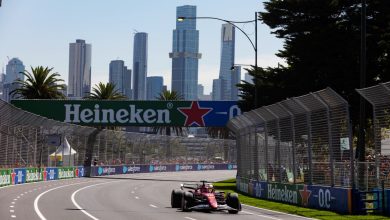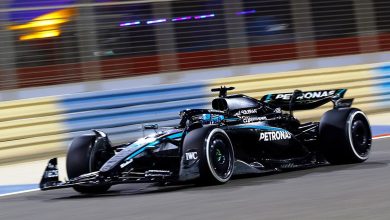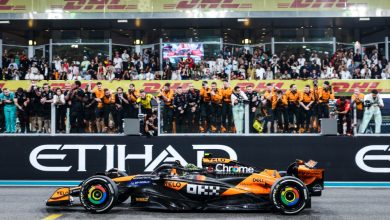Never believe what the newspapers are writing, quips Nico Rosberg after taking pole at Hungarian GP

DRIVERS
1 – Nico ROSBERG (Mercedes)
2 – Sebastian VETTEL (Red Bull Racing)
3 – Valtteri BOTTAS (Williams)
TV UNILATERAL
Congratulations Nico. It was a dramatic qualifying session wasn’t it, what with the rain, going off at the first corner etc. What was it like from the cockpit?
Nico ROSBERG: Yeah, quali three was really a big challenge, because the track was just changing all the time in the beginning and especially starting the lap with that first set of options, I was the first one to arrive in the first corner. It was just difficult to judge: how much risk can I take, how late can I brake? It was very, very wet, so I did take it a bit easy and managed to avoid crashing. For Kevin? I guess… It was just massively difficult down there and unpredictable. That can happen. From then on it was easier. It just started drying again and especially my last lap, I really managed to nail it.
And a really big margin as well. Well done. Sebastian, at one point it looked as though you nearly had him, you looked as though you were nearly going to be on pole. Where has the speed come from this weekend?
Sebastian VETTEL: I think probably the nature of the track suits us a bit more – less straights. I think historically we’ve always had a competitive car around here. It seems that we are a little bit closer but obviously Nico’s final lap was very good so the gap was again quite big – bigger than we were hoping for, because as you mentioned if we get everything perfect and Nico maybe has a bit of a wobble, we can have a crack, but it didn’t happen. They did a god job. Obviously Q3 was a mixed bag, it could have been anything, so therefore with the more dry conditions at the end to get second was the optimum.
Well done, thank you. Valtteri, once again in the top three. You weren’t expecting to be quite so quick at this circuit. Is this a bit of a surprise? Well done by the way.
Valtteri BOTTAS: Thank you, yeah. I think maybe a little bit of a surprise. We knew that Red Bull are going to be really quick here and also Ferrari and obviously Mercedes like always. Like Seb said the nature of the track in theory is not the best for us, but we’ve been able to work well as a team to bring some updates, which really worked well. Obviously we’re still missing some grip compared to some other cars but today was, I think, a really good day from us. Third and sixth, we have a good chance also here to get some really good points.
Now Nico, tomorrow in the race itself, there’s the possibility of rain again, your main championship rival and team-mate starts right at the back, what are your thoughts?
NR: Yeah, that’s been a pity for the team. Not a good thing definitely and we need to keep on working on that. That’s reliability. Also, I would be prefer to be out there battling with Lewis. That would give me the maximum adrenalin rush. Like this… of course, I’m very, very happy but it wasn’t a gloves off battle with Lewis and that takes away a little bit of the ecstatic happiness. But anyway, tomorrow’s still going to be a long race and a challenging race, especially with the weather coming, so still all to play for.
PRESS CONFERENCE
Q: Nico, yesterday you said you were a bit surprised you were so quick, and you needed to find the time. Did the track come to you or did you managed to find the time, basically, through adjustments, modifications to the car…
NR: That was two opposing statements there… ‘you were quick but you needed to find the time…’
That’s what you said… you were surprised you were so quick but you still needed to find the time. This is a quote!
NR: Never believe what the newspapers are writing!
This is from your own press release…
NR: Oh, OK, never believe what the press officers are writing! No. I’ve been surprised that we’ve been able to be so quick this weekend. I think our engine is definitely very, very strong and here the engine doesn’t come into play so much, so maybe the gap would be a little bit smaller but in fact it’s as big as anywhere really here and that’s been great to see. Really cool. It just goes to show how good our car is also.
Q: Did you change much overnight?
NR: It’s been an ongoing process, yeah. I mean, with FRIC not being on the car it’s still finding my way and finding our way because it does impact the car a lot, especially on a track like here in Budapest. A lot of long corners and fast, flowing corners – but really got there and I’m pleased with where we are now.
Q: Sebastian, tomorrow, can you take the fight to Mercedes? I guess that’s the question everyone wants to know.
SV: It depends. I think we are here to fight, we want to do that. If it rains, I think we definitely have a better chance than in normal, standard dry conditions but even then, I think we were closer this weekend. Long run pace, yeah, looked a lot better on Friday compared to them. Obviously hard to judge how much they were sandbagging or running different modes on Friday. So, it should be closer than in the last couple of races, definitely. I think we can have a good fight with the Williams, which seems to be out of reach the last couple of races.
Q: So the question is to Valtteri, can you be second? Can you even be first?
VB: I think, y’know, if nothing special is going to happen, first is really difficult. Still Mercedes is ahead – but you never know. We need to aim for that, always, and aiming for that we can get good results. Obviously here, tomorrow, it’s going to be a really close fight, like Seb said, with Red Bull and us. So we need to see how the pace is. If it’s enough, keeping them behind, at least one of them, that would be good.
QUESTIONS FROM THE FLOOR
Q: (Peter Farkas – Auto-Motor) Sebastian, I think it’s fair to say that you looked convincingly quicker than Daniel throughout the weekend here. Is it because the track suits you or have you found something in the car or are you getting more comfortable with it?
SV: I don’t think I was that much quicker, I think it was fairly close all qualifying and practice as well. Since yesterday afternoon the car seemed to be coming my way a little bit and naturally then you pick up some pace. We didn’t have anything new on the car compared to last week in Hockenheim – it’s only one week ago – so I think probably the conditions, tyres seemed to help me maybe a little bit to pick up some pace.
Q: (Peter Vamosi – Vas Nepe Kiadoi) Valtteri, what do you think right now halfway through the season, you are fifth in the championship? Is there more, can you fight against Mr Vettel and Alonso?
VB: Well, we’re always aiming for more. I think there’s still a long way to go and double points in the last race so a lot more is possible. I think personally, in the drivers’ points, I think it would be good to aim to be third. I think it is possible this year with the car we have and if we keep improving like we’ve done so far, so that should be the aim.
Q: (Heikki Kulta – Turun Sanomat) Valtteri, is it a big help to you to have a cleaner side at the start?
VB: Yeah, this season many times, I’ve been on the dirty side so it is always better to be on the clean side and we’ve normally had some really good race starts and hopefully we’ll have a good one tomorrow as well, so we will see. It’s quite a long run to the first corner, so the start will be very important.
Q: (Graham Keilloh – F1 Plus) Sebastian, towards the end of Q3, to what extent was the rain that we’d had still making a difference? If it was making a difference, was it helping you get closer to Nico or further away?
SV: I think the first run – obviously we saw Kevin lost it into turn one – was affected by the track being damp, first couple of corners, but I think the last two runs, everyone had no problem, it was completely dry.
Q: (Livio Oricchio – Universo On Line) Nico, the fact that your teammate is at the back of the grid, does that change anything for you in the race, start in a different way, maybe new goals because it will be harder for him?
NR: Well, it makes it easier of course, because he’s my competitor number one, so I will play it even more safe and just really try and avoid any unnecessary things happening and make sure to get as many points as possible because it’s really a free opportunity tomorrow.
Q: (Viktor Bodnar – Magyar Szo) Nico, can you imagine how you would feel yourself if you were in Lewis’s place with this series of bad luck?
NR: Well, it’s massively disappointing when the car breaks down. I had it two races ago at Silverstone in the lead that the car broke down. It’s tough, it definitely is tough because it’s not something that you can control, you know, so that makes it really difficult..
Q: (Peter Farkas – Auto-Motor) Nico, it’s been anticipated on this track the ban on FRIC would have a greater effect since the corners are a bit longer and the track is bumpier. Have you felt that that was the case, this is why Red Bull was a little bit closer?
NR: For sure it had a big effect, yes, but I think it affected everybody, because everybody had the FRIC system in one way or another and so it seems that we’ve held on to our advantage and I’m very very happy to see that because it wasn’t sure how it was going to go, if some teams might benefit more than others. What was sure was that we had a good system so we were very confident ours was really good but it seems that we’ve held on which is great.
Q: (Peter Vamosi – Vas Nepe Kiadoi) To all drivers: next year, the Hungaroring will have its thirtieth Formula One race here. If you could change something on the track, corners, facilities, whatever, what would you do?
NR: Well, it’s a fantastic race to come to here you know, the fans are so excited and also it’s very international, there’s a lot of Finnish fans, also a lot of German fans, so for me it’s great. Yeah, it’s always nice to come here. What would we..? I don’t know, it’s difficult to say what to change because it’s a great track, it’s very challenging, it’s like a little street circuit but as a real track. It’s very tough, so I wouldn’t change much, I’d keep it like it is.
SV: Since there’s large interest I would probably put more grandstands next to the track so that some of the people don’t have to stand all the time. Other than that, I wouldn’t change anything.
VB: Yeah, facilities and everything are really nice, lot of fans, lot of support so that is good but I have to say that as our car is quite slick in the straights, that this year I would change the track a bit, bit longer straight. Seb, do you agree, for next year?
SV: No, I’d rather go free beer for your fellow countrymen!
Q: (Silvia Arias – Parabrisas) I would like to know, Sebastian and Valtteri, do you feel as well this impact without FRIC that Nico was talking about?
SV: Obviously I think some people were more advanced than others. For us, it didn’t make a big big difference. We had something but yeah, I think we’re more or less as competitive as we were before so it didn’t change much.
VB: No big difference, no, and we’ve improved since last weekend for sure, with the current suspension, but I don’t think it’s the key point of the season.
Q: It’s always said to be very difficult to overtake here; is it any easier with this generation of cars or is it still very difficult?
SV: In a Williams, I guess it’s fantastic down the straights, you know, you’re so quick but it depends. I think it’s always been difficult and it will be difficult tomorrow.







